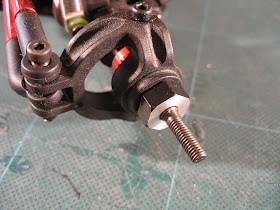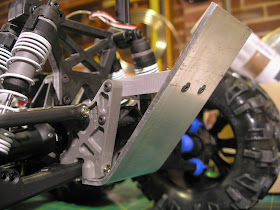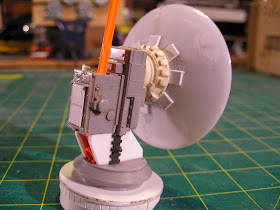Fairly typically I have started a new project ( actually quite a few) without completing the old ones. I cant help myself, I do so much thinking about a model over a long period of time that once it is underway my mind starts to wander and think about the next one. A new idea can be sparked by some left over parts from some previous experimentation, or by something seen on various forums. It sometimes takes a while to amass the parts required and come up with concept thumbnails that lead to a design I like, and at other times I get obsessed and I just have to start now.
This one is the latter, the chassis at least came together relatively quickly.
As the title states it is an 8X8, based mostly on traxass E-maxx parts. I got this idea from looking at this modellers site
http://www.krohpit.ru/2012/10/8x8.html
My version is nowhere near as sophisticated and although much simpler mechanically, has not been as straightforward as it looks on first glance.
This is the thumbnail sketch I settled on for the body.
I then did some preliminary modeling to scale in Autodesk Maya to refine the design.
Then using the side view picture I knocked up a full size cad drawing in DraftSight.
I purchased a pile of E-maxx parts off Ebay, some new and some secondhand from a guy who also had some wheels and tyres he wanted to offload cheap. 4 of them were traxxas Summit wheels and tyres. I figured I may as well use these on this model and got 4 more new ones, again from E-bay.
While the wheels themselves are pretty solid ( fake beadlocks) and relatively cheap for their size from the E-bay parts dis-mantlers, the Canyon tyres are extremely thin walled, like a thick rubber glove. In consequence they do hug the terrain well but by all accounts are easily ripped on sharp stones. In this case they will probably do fine, time will tell.
Here is the chassis so far, it is big, bloody big... overall 900mm long. The body will add to this length eventually.
It is powered by a DeWalt brushed 14.4 volt motor via a EVX2 speed controller. The transmission is my usual choice, namely the Summit two speed for that low speed, high torque capability. We will see if this will be enough to move this beast, I have not as yet tested it. The two front sets of wheels are steered.


The transmission speed selection servo is an old mini futaba that I have had for years sitting in a box. I purchased this servo from an aborted movie production in 1987. The movie Total recall was originally being made in Australia, in Sydney by Dino Delaurentis and going to be directed by Bruce Beresford. Then the '87 stock market crash happened and the movie got canned after about 6 months worth of visual effects miniatures had been built. I had some friends who were working on the models for the film, they had a big firesale and I purchased a couple of the incomplete vehicles. One was a 6 wheeled rig made from Thunder Tiger Silver Fox parts and one was the Tamiya 1/16th RC Leopard tank ( which I stupidly sold many years ago), the servo came as part of these.

The aluminium top plate has had a small recess milled into it to clear the spring lever for the two speed shifter. I don't have a milling machine and only a tiny Emco Unimat3 lathe. For this task I use a Dremel bit that looks like a tiny 3 flute end mill in my small 5 speed drill press and very slowly push the plate around by hand nibbling away at the metal. It is not the most ideal set up but it's all I have. I would dearly love a small milling machine and a bigger lathe but at the moment they are just a bit too far out of reach for my meagre purchasing power. The Unimat 3 which I have had since 1990 is very useful for making links and spacers but cant really handle much larger tasks. I don't even have a 4 jaw chuck to hold square items but its better than trying to file parts mounted in a spinning drill and way better than nothing.

The maxx steering post has had to be slightly modified so the lever comes off at 90 degrees to the original position. It is made from Pvc and is super glued to the servo saver part. I hope it stands up to use. If it doesn't I will have to engineer something stronger. The front most steering arm is slightly longer than the inner one. It has a hole further out from the centre so that the front most steering turns slightly less than the inner. The inner set of front wheels turns on a smaller radius then the outer set so the slightly smaller movement that results should compensate. Note that I did not actually calculate any angular mathematics for all this, thats just not my strong point, I just basically winged it. I am pretty sure however, that this vehicle is going to have a relatively large turning circle.


. The diffs at each end are Maxx diffs, but the two inner ones are modified Revo diffs. Unlike the Maxx diffs which have a left and a right side, the Revo diffs have a back and front half so it is easy to get a second set of diff cases and bolt two front halves together along with a second pinion gear and bearing. This makes a diff that has an input and an output pinion for attaching to the driveshafts that lead to the transmission at one end and the end diff at the other. There is a little lip on the diff cases that has to be sanded off so they mate flush. Then there is a big job in dremeling out the Maxx diff bulkheads to fit these Revo diffs. This is the hardest part of the conversion. I had to also make some new pvc parts to hold the Revo diffs in the Maxx bulkheads so they don't rotate, much like the transverse collar that comes with the Maxx diffs. It also helps that the Maxx and Revo diffs have the same ring and pinion gears so the axles all turn at the same speed.
The other catch is that the front diff bulkheads are designed to be mounted angled up for front castor purposes. In this case they are mounted flat and the transverse diff collar holes expect this. I had to make a new PVC block to act as a transverse collar holding the diffs at a corrected angle. Originally I made a large block that bolted to the bottom chassis plate but this ended up fouling the steering bellcranks. The blocks had to be removed and remade to bolt to the top plates. That is why there is a couple of unused countersunk holes in the front bottom chassis plates. It is really a very tight fit around the steering beelcranks with a thick drive shaft running through the middle of it and the locking the diffs in place. It was quite a fiddle to sort out. This is one of those occasions where a milling machine would have been handy. I could have made entirely new bulkheads that alleviate all the problems that adapting existing parts throws up.
You have to remember to alternate the ring gear side of the diffs as you go down the chassis so all the axles turn in the same direction, otherwise if they line up all on the same side some of the axles will be going forward while others are going backwards.
 |
| Maxx diff at both ends. |
 |
| Modded Revo diffs in the middle. |
 |
| Aluminium brace made up to clear the drive shaft for the inner rear diff. |
Various reinforcement blocks of 10mm Pvc have been made to tie all the bits together.
I am planning to build the body out of PVC foam sheet to try to keep the weight down a bit.
Next to go is the battery and ESC mounting positions, then I can test it out...




































































